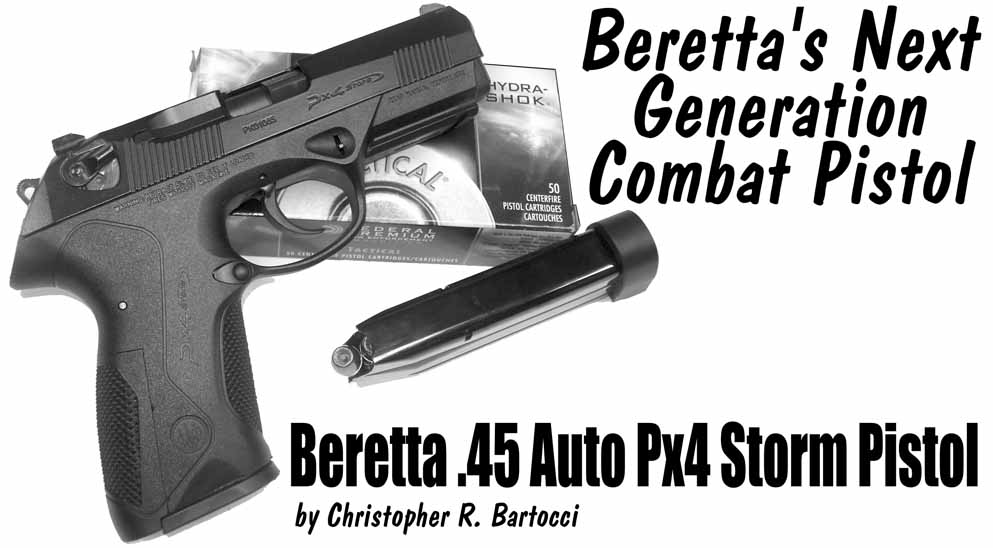By Christopher R. Bartocci
Beretta is well known for their legendary 92 series of semiautomatic pistols. The 92FS has had worldwide acceptance as a military and law enforcement pistol since the early 1980s. Much of its success is due to its adoption as the M9 service pistol in 1985 as the official sidearm of the United States forces. Although challenged many times, the M9 has proven itself to be reliable. The poor stopping power of the 9x19mm M882 Ball round and poor quality government low bid magazines have hurt the legendary weapon’s reputation. With the adoption by U.S. forces, it sprung its popularity to record levels almost overnight with American law enforcement. The 92 series design has been produced steady and continuous to this day with additional M9 pistols being procured for the Global War On Terrorism.
There was a technology change in the firearm industry in the early 1980s with the advent of polymer frame pistols introduced by Glock with their Model 17. Although too new for many to accept at the time, polymer frame pistols have arrived and are here to stay.
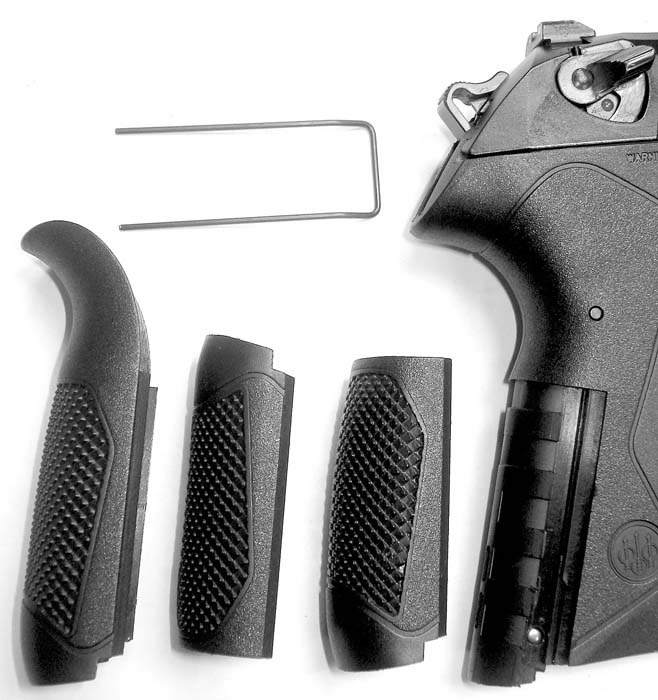
Beretta research and development continued on a new family of pistols that was not based on the 92 series. It would adapt some of the trigger mechanism but the locking system would be entirely different. The locking system would be taken from a Stoner/Knight design, which would then be introduced to the commercial and military markets by Colt. In 1992, Colt introduced their All American 2000 pistol. This was the first production pistol to use the Stoner/Knight rotating barrel locking mechanism. It worked similar to the rotating bolt on an M16. The barrel rotated on a cam and locked up in the cam slot, front and rear of the side locking areas. This made the recoil more inline creating less muzzle-flip on the unlocking stage. Due to the extent of the locking surfaces, it made the pistol more accurate. During the end of the finalization of the AA2000 design, Colt entered a Special Operations competition for the OHWS (Offensive Handgun Weapon System). Colt decided to incorporate the new rotating barrel mechanism into their candidate to be submitted for testing. The final OHWS competition was down to two guns, one by Colt and the other by Heckler & Koch. The winner was to be dubbed the Mk 23 Mod 0. The Colt entry was a blend of characteristics from three pistols. It had the rotating barrel of the AA2000, utilized the grip design and safety lever of the M1911 and the trigger and decocker were taken from their Desert Eagle design. In the end, the polymer frame Heckler & Koch pistol would win the contract and the AA2000 would be taken out of production. The failure of the All American was in the end not due to the rotating barrel but the trigger. The design that Stoner/Knight provided Colt had an excellent trigger for this striker fired pistol, but Colt’s final design had a very poor heavy trigger. Due to legal considerations, Colt made a heavy trigger with much creep.
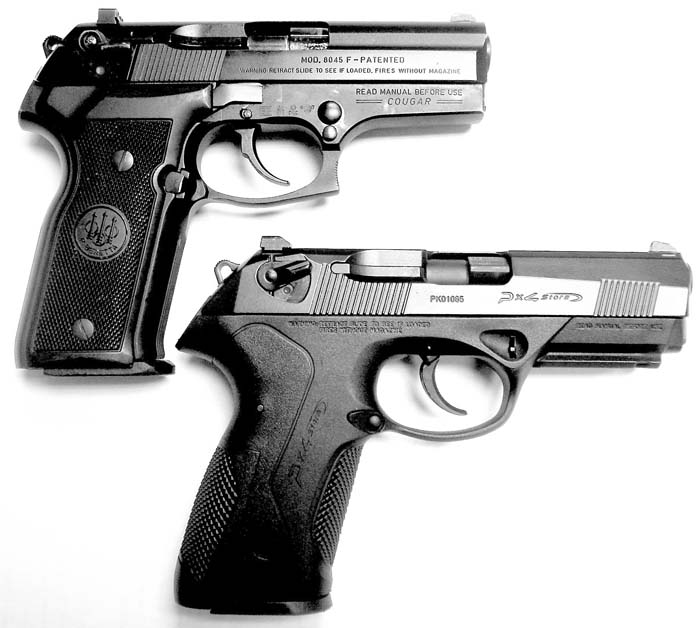
Beretta introduced a new family of pistols reviving the rotating barrel design: the Cougar family of pistols. These pistols were introduced in 9mm NATO, .40 S&W, .357 SIG and .45 ACP. The frame would use a traditional double action trigger. The design is very similar to that of the 92 series. The pistol has an aluminum frame and would disassemble similar to the 92 series. The slide incorporated a firing pin block safety and a thumb lever that worked as a safety and decocker. Like the 92 series, the Cougar series would be introduced in decock-only and double action only. The Cougar design did find its way into the market and into the hands of Police Departments. However, the introduction of the .45 caliber Cougar put Beretta into a place in the market that few had been. At the time of the release, several agencies decided they wanted to steer clear of the 9mm caliber pistols due to poor terminal performance. They wanted to bring back the .45 Auto for duty use. At this time (1994), there were few double action .45 Auto pistols on the market. The Smith & Wesson 4506, Glock 21, SIG Sauer P220, Heckler & Koch USP and now the Beretta 8045 Cougar. The 8045 Cougar was Beretta’s first .45 Auto caliber pistol since their establishment in 1526. The S&W 4506 was a large pistol and that family of weapons was not known for durability. The Glock 21 was the most successful but many agencies hung their hat on pistols with manual safeties, which kept Glock out of the running for some of these agencies. So the top three would be the SIG, H&K and Beretta pistols. Although comparable in many ways, the price tags were not. Beretta priced their pistols very reasonably compared to H&K and SIG and, for a large agency, this made a difference. The Beretta Cougar found its niche.
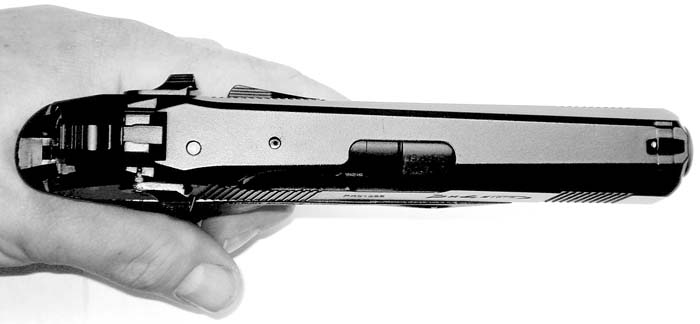
The Rochester Police Department was the first large agency to buy the new 8045 Cougar .45 Auto pistols. However, the success of the Cougar series was to dwindle in the early 2000s. Beretta would discontinue the line in 2005 and it would be picked up by Stoeger and introduced at the 2006 SHOT Show in Orlando Florida.
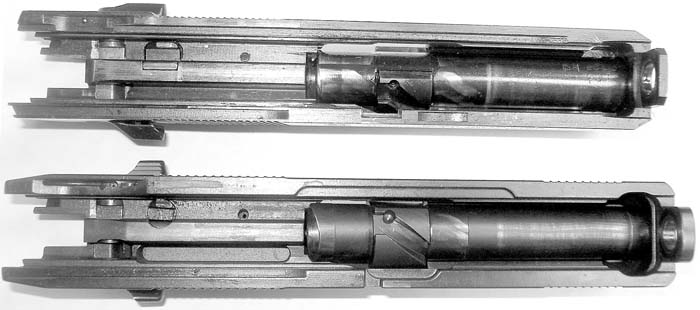
In the early 2000s, Beretta initiated a new program for a new family of pistols; not to replace the 92 series, which is still going strong, but an entirely new family of weapons. This time the pistol would be built on a polymer frame and have all the benefits a polymer frame would offer. Beretta experienced much success in both reliability and accuracy with the rotating barrel locking system and would keep that. Beretta listened to the users of the Cougar and to their complaints and took them into consideration with the design of the new Px4 Storm family of weapons.
To the untrained eye, the Px4 Storm would look like a polymer frame Cougar. That is the farthest from the truth. The only real similarity is the Px4 Storm’s use of the rotating barrel. The Px4 Storm was designed as a military/law enforcement pistol with emphasis being on military use – meaning military grade/combat reliability. At the same time of the development of the Px4 Storm family of weapons, in 2005, SOCOM put out a requirement for a new .45 Auto caliber pistol. Beretta immediately went to work on a Px4 Storm-type pistol to fit the SOCOM requirements. While both pistols were designed simultaneously, the .40 caliber Px4 Storm was the first one to be introduced in 2005 and was soon followed by the 9mm NATO. The first prototype .45 Auto caliber Px4 Storm pistols were introduced at the 2006 SHOT Show. Beretta finished their Special Operation Forces pistol that met the requirements put forth by SOCOM. However, the program was dropped by SOCOM and the pistol never had the opportunity to compete. The 27.69 ounce pistol was given the model name Px4 Storm SD (Special Duty) and is easily distinguished from the Px4 Storm due to its green polymer frame, black slide and extended barrel for the installation of a silencer. The internal parts have special finishes to conform to the corrosion requirement of the SOF specifications that included a 10-day salt-spray test. Small quantities of the .45 Auto caliber Px4 Storm pistol have been produced as test & evaluation pistols for law enforcement agencies. As of this writing, some shipments are being imported to fill orders and full production is expected in the first quarter of 2008. We will examine the Px4 Storm pistol in this article with emphasis on the .45 Auto caliber pistol. Currently, all of the compact versions of the Px4 Storm are made at the Beretta U.S.A. plant in Accokeek, Maryland. All of the full size Px4 Storm pistols are manufactured in Italy.
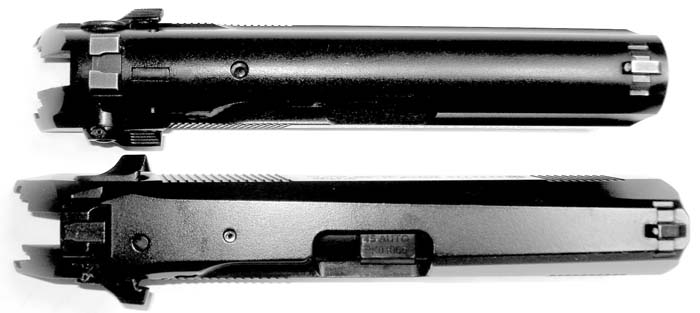
The frame of the Px4 Storm is black reinforced fiberglass polymer. The frame is injection molded in two pieces. Unlike the Cougar, the Px4 Storm is designed to be +P rated. This design was per the SOCOM requirement for their SOF pistol. Unlike many current production pistols, the original Px4 Storm was designed as a .40 S&W caliber pistol and then scaled down to a 9mm NATO caliber. The .45 Auto pistol has a different frame that is specifically designed for the .45 Auto caliber cartridge. When compared to the Cougar, several changes are noted. First, the Px4 Storm has a Mil-Std-1913 accessory rail on the front of the pistol. The scaled pattern back strap is removable and comes with three different back strap replacements. Each gets a little larger to thus accommodate small, medium and large size hands. The user merely pulls out the back strap retaining spring and slides the backstrap out of the bottom of the pistol. Also available are two different hammer spring caps: one which accepts a lanyard and one that is flush. The slide is removed by pulling downward on a slide lock on the frame, similar to a Glock. However, the pistol does not have to be decocked. The trigger has the natural curve similar to the 92 and Cougar series. The trigger weight specifications are 8.8 to 12.1 pounds for double action and 3.5 to 6.2 pounds for single action. The hammer mechanism is removable and interchangeable. It is housed as one unit and can be easily removed and the entire unit replaced if need be permitting easy maintenance and cleaning. This will also permit the user to switch to the G (decock only), D (double action only) or the C (constant double action only with shorter and lighter trigger pull) variation. The magazine release is reversible as well and done by an armorer. Additionally, extended size buttons can be used for those who prefer it. The trigger guard is large enough to accept most types of gloves. The front strap has checkering on it as well as the backstraps. Pebbling finish is on the rear area of the grips to assist with gripping in harsh environments (mud, water, sweat, etc.). The slide release in on the left side and can be actuated by most shooters without having to change their grip on the pistol. The ergonomics of the grip angle is also a major improvement over the Cougar.
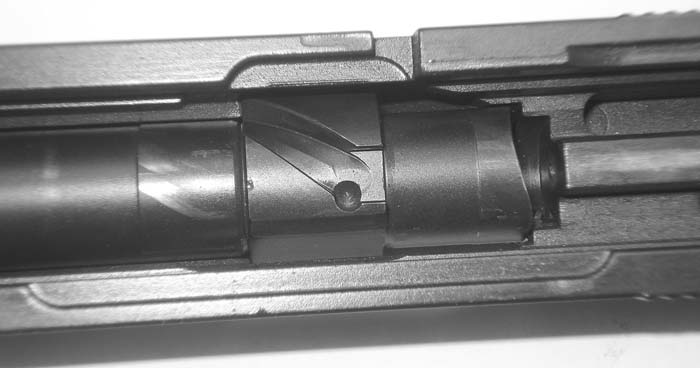
The 1.42 inch thick slide is manufactured from a solid piece of carbon steel and finished by sandblasting, phosphated and then finished off with Beretta’s own Brunition anti corrosion finish. The slide is quite different from the Cougar as well with all the sharp edges having been removed. The Px4 Storm has a slender and smoother profile. Gripping serrations are added to the front of the pistol as well. The slide has an ambidextrous safety/decocking lever. This mechanism is a significant improvement over the Cougar/92 series eliminating most of the springs and small parts making assembly and disassembly easier. The slide contains a visible firing pin block mechanism that was redesigned. The firing pin is in two pieces like the 92 and Cougar series. There is a plunger located in the thumb safety as well as a firing pin. When the safety lever is rotated down to decock, the plunger is out of alignment with the firing pin eliminating the possibility of discharge. Also at this point, the firing pin block is engaged. The Px4 Storm pistols all come with proprietary sights that Beretta calls Superluminova. These are sights which are an epoxy resin mixed with a fluorescent powder. This is then placed in the sights. How they work is when the officer goes into a tactical situation, he can take a flashlight, blast the front and rear sight for a couple seconds and the sights are illuminated to a bright green for a minimum of 30 minutes. This is a very inexpensive enhancement that will give anyone the capability of night sights. However, Trijicon tritium sights will also be available.
The rotating barrel is manufactured from a solid piece of carbon steel. The barrel is cold-hammer forged and as per military specification, internally chrome plated and externally finished with black oxide. The cam track is located on the bottom of the rear of the barrel. There are locking surfaces on the wings of the barrel. The feed ramp is part of the barrel chamber. When the slide and barrel are installed on the pistol and a loaded magazine inserted, it is visibly seen the direct magazine to chamber feed increasing reliability. The barrel has been significantly improved over the Cougar to military grade. The central block has a larger and stronger cam pin to lock and unlock the barrel. The recoil spring is designed not to fall out of the gun when disassembled like the Cougar. The central block on the Cougar has a hollow channel for the spring guide. The central block on the Px4 Storm has an enclosed rear making reassembly easier. The rotating barrel locks on the cam, rear portion of the breach face as well as the front of the slide in front of the ejection port. Additionally, the enlarged outer barrel muzzle diameter insures precise and constant barrel-to-slide coupling, which is an accuracy enhancement.
The magazines for the .45 Auto Px4 Storm is different from the Cougar as well. The Cougar only holds 8 rounds of .45 Auto ammunition. The Px4 Storm has two magazines. One holds 9 and the other holds 10. The floor plate on the 10 round magazines is larger.
During the development of the .45 Px4 Storm, most all of the available high performance ammunition was tested and functioned flawlessly in the pistol. During test firing of this pistol for this article, both American Eagle 230gr FMJ and Federal 230gr Hydra-Shok ammunition was used with no malfunctions. The sample pistol was fired more than 1,000 rounds. One thing noticeable was the recoil. Also out that day the Px4 Storm was fired was a new Smith & Wesson M&P .45 pistol, which uses the standard browning-type recoil operating system. The Px4 Storm felt much more as a push due to the inline cycling of the slide that enhanced the controllability on rapid fire. The M&P had much more of a snap, which is more consistent with that form of locking mechanism. This similar feeling is noted when firing a Beretta 92/96 Series pistol as compared to a Glock or a SIG Sauer pistol which are recoil operated as well.
The market is now flooded with new .45 Auto caliber pistols and many are aimed at the SOCOM market as well as the U.S. military. The U.S. Army has hinted they will be looking for a new non-9mm caliber service pistol. You can bet the Px4 Storm will be in line to compete for the next service pistol.

I would like to thank Len Lucas and C.R. (Van) VanDerscoff III from Beretta U.S.A. for their time and effort researching this new Beretta pistol and Sgt. Robert Duff of the Rochester Police Department Firearms Training Unit.
| This article first appeared in Small Arms Review V11N9 (June 2008) |



